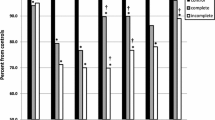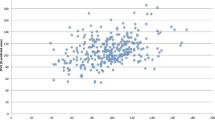Abstract
Congenital heart disease promotes hemodynamic changes that can contribute to reduce exercise capacity. The aim of the study was to evaluate the exercise capacity of children and adolescents with cyanotic congenital heart disease and to assess respiratory muscle strength, plasma levels of B-type natriuretic peptide and ventricular ejection fraction, as well the associations between these variables. Cross-sectional study that evaluated 48 patients between 6 and 18 years-old that underwent a six-minute walk test (6MWT), respiratory muscle strength, dosage of B-type natriuretic peptide and echocardiography. The mean age was 13.3 ± 4.1 years, and the most prevalent heart disease was tetralogy of Fallot (54.2 %). The average distance walked was 452.7 ± 73.2 m, significantly below the predicted (69 %) (p < 0.001). The maximum inspiratory pressure was above the predicted result (111.4 %), average 58.2 ± 22.3 (p = 0.56), and the maximum expiratory pressure was 63.2 ± 23.3 cm H2O, significantly below the predicted (63 %) (p < 0.001). The level of B-type natriuretic peptide was elevated in all patients, with a median of 2087.17 (502.54–4,768.05). The ventricular ejection fraction showed a median of 65.9 (41–100). There was no correlation between the 6MWT, ventricular ejection fraction (r = −0.05; p = 0.72), inspiratory muscle strength (r = 0.03; p = 0.81), expiratory muscle strength (r = 0.09; p = 0.05) and B-type natriuretic peptide (r = −0.04; p = 0.77). Children and adolescents with cyanotic congenital heart disease present a lower exercise capacity and expiratory muscle strength. No associations were found between exercise capacity, respiratory muscle strength, B-type natriuretic peptide and left ventricular ejection fraction.
Similar content being viewed by others
References
Adatia GJ, Kempt DJ, Taylor GK, Radda GK, Rajagopalant B, Haworth SG (1993) Abnormalities in skeletal muscle metabolism in cyanotic patients with congenital heart disease: a 31P nuclear magnetic resonance spectroscopy study. Clin Sci 85:105–109
American Thoracic Society (2002) Statement guidelines for the six-minute walk test. Am J Respir Crit Care Med 166:111–117
American Thoracic Society/American College of Chest Physicians (2003) ATS/ACCP statement on cardiopulmonary exercise testing. Am J Resp Crit Care Med 167:211–217
American Thoracic Society/European Respiratory Society (2002) ATS/ERS statement on respiratory muscle testing. Am J Respir Crit Care Med 166(4):518–624
Auslender M (2000) Pathophysiology of pediatric heart failure. Prog Pediatr Cardiol. 11:175–184
Bar-Mor G, Bar-Tal Y, Krulik T, Zeevi B (2004) Self-efficacy and physical activity in adolescence with trivial, mild, or moderate congenital cardiac malformations. Cardiol Young 14:373–379
Baumgartner H, Bonhoeffer P, De Groot NM, de Haan F, Deanfield JE, Galie N et al (2010) Task force on the management of grown-up congenital heart disease of the European Society of Cardiology (ESC); Association for European Paediatric Cardiology (AEPC). ESC guidelines for the management of grown-up congenital heart disease (new version 2010). Eur Heart J 31(23):2915–2957
Carvalho JS, Shinebourne EA, Busst C, Rigby M, Redington AN (1992) Exercise capacity after complete repair of tetralogy of Fallot: deleterious effects of residual pulmonary regurgitation. Br Heart J 67:470–473
Cheung EWY, Lam WWM, Chiu SCW, Cheung SCW, Cheung YF (2007) Plasma brain natriuretic peptide levels, right ventricular volume overload and exercise capacity in adolescents after surgical repair of tetralogy of Fallot. Intern J Cardiol 121(2):155–162
Daliento L, Mapelli D, Russo G, Scarso P, Limongi F, Lannizzi P, Melendugno A, Mazzotti E, Volpe B (2005) Health related quality of life in adults with repaired tetralogy of Fallot: psychosocial and cognitive outcomes. Heart 91:213–218
Daniels L, Maisel AS (2007) Natriuretic peptides. J Am Coll Cardiol 50(25):2357–2368
de Lemos JA, McGuire DK (2003) Drazner MH—B-type natriuretic peptide in cardiovascular disease. Lancet 362:316–322
Domenech-Clar R, López-Andreu JA, Compte-Torrero L, De Diego-Damiá A, Macián-Gisbert V, Perpiná-Tordera M et al (2003) Maximal static respiratory pressures in children and adolescents. Pediatr Pulmonol 35(2):126–132
Elved R, Frederick KWL, Kevin S (2006) Validity of the 6-minute walk test for assessing heart rate recovery after an exercise-based cardiac rehabilitation programme. Physiotherapy 92(2):116–121
Geiger R, Strasak A, Treml B, Gasser K, Kleinsasser Fischer V, Geiger H et al (2007) Six-minute walk test in children and adolescents. J Pediatr 150:395–399
Greutmann M, Le Lan T, Tobler D, Biaggi P, Oechslin EM, Silversides CK, Granton JT (2011) Generalised muscle weakness in young adults with congenital heart disease. Heart 97(14):1164–1168
Haddad F, Hunt SA, Rosenthal DN, Murphy DJ (2008) Right ventricular function in cardiovascular disease, part I: anatomy, physiology, aging, and functional assessment of the right ventricle. Circulation 117(11):1436–1448
Inai K, Saita Y, Takeda S, Nakazawa M, Kimura H (2004) Skeletal muscle hemodynamics and endothelial function in patients after Fontan operation. Am J Cardiol 93:792–797
Khoshnood B, Lelong N, Houyel L et al (2012) Prevalence, timing of diagnosis and mortality of newborns with congenital heart defects: a population-based study. Heart 98:1667
Kruger S, Graf J, Kunz D, Stickel T, Hanrath P, Janssens U (2002) Brain natriuretic peptide levels predict functional capacity in patients with chronic heart failure. J Am Cardiol 40(4):718–722
Kuczmarski RJ, Ogden CL, Guo SS, Grummer-Strawn LM, Flegal KM, Wei R et al (2000) CDC growth charts for the United States: methods and development. National Center for Health Statistics. 2002 Vital Health Stat 11(246): 1–190
Lang RM, Bierig M, Devereux RB et al (2005) Recommendations for chamber quantification: a report from the American Society of Echocardiography’s Guidelines and Standards Committee and the Chamber Quantification Writing Group, developed in conjunction with the European Association of Echocardiography, a branch of the European Society of Cardiology. J Am Echocardiogr 18(12):1440–1463
Matthews IL (2006) Per Morten Fredriksen, Per G. Bjørnstad, Erik Thaulow, Morten Gronn. Reduced pulmonary function in children with the Fontan circulation affects their exercise capacity. Cardiol Young 16:261–267
Moalla W, Gauthier R, Maingourd Y, Ahmaidi S (2005) Six-minute walking test to assess exercise tolerance and cardiorespiratory responses during training program in children with congenital heart disease. Int J Sports Med 26(9):756–762
Moola F, Faulkner GE, Kirsh JA, Kilburn J (2008) Physical activity and sport participation in youth with congenital heart disease: perceptions of children and parents. Adapt Phys Activ Q 25(1):49–70
Moola F, McCrindle BW, Longmuir PE (2009) Physical activity participation in youth with surgically corrected congenital heart disease: devising guidelines so Johnny can participate. Paediatr Child Health 14(3):167–170
Neil F, Sear JW, French G et al (2000) Increases in serum concentrations of cardiac proteins and the prediction of early postoperative cardiovascular complications in noncardiac surgery patients. Anaesthesia 55:641–647
Nixon PA, Joswiack ML, Friecker FJ (1996) A six-minute walk test for assessing exercise tolerance in severely ill children. J Pediatr 129(3):362–366
Norozi K, Gravenhorst V, Hobbiebrunken E, Wessel A (2005) Normality of cardiopulmonary capacity in children operated on to correct congenital heart defects. Arch Pediatr Adolesc Med 159:1063–1068
Pedra CA, Haddad J, Pedra SF, Peirone A, Pilla CB, Marin-Neto JA (2009) Paediatric and congenital heart disease in south America: an overview. Heart 95(17):1385–1392
Pfeiffer ME (2012) Teste de exercício cardiopulmonar em cardiopatas congênitos: visão do cardiopediatra. Rev DERC 18(4):114–117
Santos BGM, Moraes NS, Ibrahim MAR, Santos IM, Santos SC (2012) Correção cirúrgica de cardiopatias congênitas em recém-nascido. Insuf Card 7(4):184–189
Schulze-Neick I, Hartenstein P, Li J, Stiller B, Nagdyman N, Hubler M, et al (2003) Intravenous sildenafil is a potent pulmonary vasodilator in children with congenital heart disease. Circulation 108(Suppl 1):II167–II173
Sen S, Bandhyopadhay B, Eriksson P, Chattopadhay A (2012) Functional capacity following univentricular repair: midterm outcome. Cong Heart Dis 7(5):423–432
Skaluba SJ, Litwin SE (2004) Mechanisms of exercise intolerance: insights from tissue doppler imaging. Circulation 109(8):972–977
Solway S, Brooks D, Lacasse Y, Thomas AS (2001) Qualitative systematic overview of the measurement properties of functional walk tests used in the cardiorespiratory domain. Chest 119(1):256–270
Stromvall-Larsson ES, Eriksson BO, Sixt R (2003) Decreased lung function and exercise capacity in Fontan patients. A long-term follow-up. Scand Cardiovasc J 37:58–63
Takken T, Hulzebos HJ, Blank AC, Tacken MH, Helders PJ, Strengers JL (2007) Exercise prescription for patients with a Fontan circulation: current evidence and future directions. Neth Heart J 15:142–147
Trojnarska O, Gwizdala A, Lanocha M, Katarzynska A, Katarzynski S, Oko-Sarnowska Z et al (2007) Exercise testing in adults after repair of aortic coarctation; evaluation of cardiopulmonar exercise capacity and B-type natriuretic protein levels. Tex Heart Inst J 34(4):412–419
Wagener JS, Hibbert ME, Landau LI (1984) Maximal respiratory pressures in children. Am Rev Respir Dis 129(5):873–875
Westerlind A, Wahlander H, Lindstedt G, Lundberg PA, Holmegren D (2004) Clinical signs of heart failure are associated with increased levels of natriuretic peptide types b and a in children with congenital heart defects or cardiomyopathy. Acta Paediatr 93(3):340–345
Wilson SH, Cooke NT, Edwuards RHT, Spiro SG (1984) Predicted normal values for maximal respiratory pressures in caucasian adults and children. Thorax 39:535–538
Informed consent
Informed consent was obtained from all individual participants included in the study.
Conflict of interest
I declare that there is no conflict of interest.
Author information
Authors and Affiliations
Corresponding author
Additional information
Academic link: This work is part of a master’s thesis.
Rights and permissions
About this article
Cite this article
Feltez, G., Coronel, C.C., Pellanda, L.C. et al. Exercise Capacity in Children and Adolescents with Corrected Congenital Heart Disease. Pediatr Cardiol 36, 1075–1082 (2015). https://doi.org/10.1007/s00246-015-1129-1
Received:
Accepted:
Published:
Issue Date:
DOI: https://doi.org/10.1007/s00246-015-1129-1




